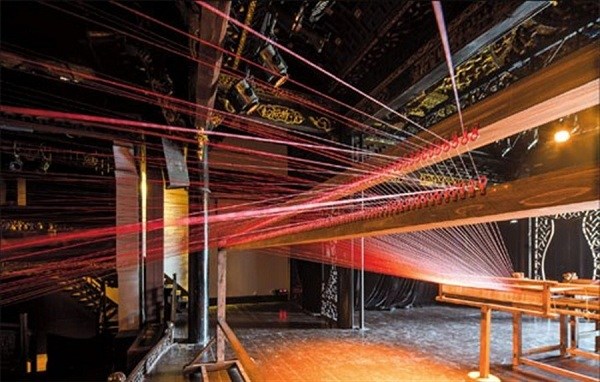Exhibition brings world-class artwork to Wuzhen
 0 Comment(s)
0 Comment(s) Print
Print E-mail China Daily, April 15, 2016
E-mail China Daily, April 15, 2016
|
|
|
"Again, Still, Yet" by Ann Hamilton |
For centuries, Wuzhen has been a sleepy water town in Zhejiang Province. Even as China notched double-digit rates of economic growth, one would have been hard-pressed to discern signs of the country's rapid development in its timeless white-washed walls, black awnings and picturesque canals.
Recently though, the town has begun to shed its placid veneer and is now emerging as one of the region's hottest art centers, thanks to events like the Wuzhen Drama Festival.
The latest arts event making waves in Wuzhen is "Utopia/Heterotopia: Wuzhen International Contemporary Art Exhibition." This extravaganza features works from some of the world's most celebrated contemporary artists, including Damien Hirst, Florentijn Hofman, Ann Hamilton and Olafur Eliasson. Of course, luminaries from China's own contemporary art scene are also represented at the ongoing event, which runs until April 26.
Most of the some 130 works on display for the exhibition can be found at the North Silk Factory, an abandoned industrial space that has been transformed into an arts venue. The pieces on view include paintings, installations, sculptures, performance works and animation; many of which are being shown for the first time in China. Meanwhile, art lovers can find a host of large-scale works — including Hofman's "The Floating Fish" and Chen Zhiguang's "Ants" — around the town's West Scenic District.
According to the event's chief curator, Feng Boyi, Wuzhen is well suited to host such an impressive event.
"The biggest advantage of Wuzhen is that it's rich, of course," explained Feng. "Also, Wuzhen has a strong sense of culture and... has accumulated experience (hosting large scale events) with the Wuzhen International Drama Festival."
Feng spent two years organizing the event. He was helped by a committee that included Uli Sigg, a noted collector of modern Chinese art.
A number of the artists taking part in the exhibition created pieces inspired by Wuzhen and the theme of "utopia." Indeed, the city's traditional wooden houses and charming river scenes have long been a source of creative inspiration.
According to Feng, people's expectations and beliefs about what constitutes an ideal society are a powerful force that can change reality.
Ann Hamilton, an American artist known for her large-scale installations, created a work called "Again, Still, Yet" in a traditional wooden opera theater. The installation comprises an old loom placed on stage with its colorful threads stretching to every chair in the theater.
She hopes visitors will use her loom installation to actually weave cloth. When the show ends on June 26, the installation will be taken away, leaving only this woven cloth.
Another massive-scale installation work comes from Mao Tongqiang, who is showing a piece that includes 30,000 hammers and sickles as a symbol of the classic Communist vision of utopia.
From the start, Feng and his team focused on including foreign artists in the event as a way to raise its profile. He says the most difficult part of bringing foreign artists to Wuzhen — a town that many of them had never heard of — was convincing them to come because they had preconceived notions about China being just the "world's factory."
But many changed their views after visiting. Some even decided to create a work or loan a piece to the town, which has a population of 60,000. Forentijn Hofman is one of them.
Hofman is known to many in China thanks to the giant rubber duck installation he brought to Hong Kong harbor three years ago. This time around, he's created a 15-meter-long pink fish constructing out of children's kickboards. The fish can be found floating in a pond next to the theater in Wuzhen.
"Contemporary art is part of the dream of Wuzhen," said Chen Xianghong, the president of Wuzhen Cultural Company, an organizer of the festival. "Some have asked me about the future of this contemporary art exhibition. My answer is that it will create new possibilities. For example, the first World Internet Conference was held in Wuzhen last year, and someone compared Wuzhen with Davos. In my eyes, Wuzhen is a defender of traditional culture, while at the same time it could also become a platform for multi-culturalism and contemporary art."







Go to Forum >>0 Comment(s)